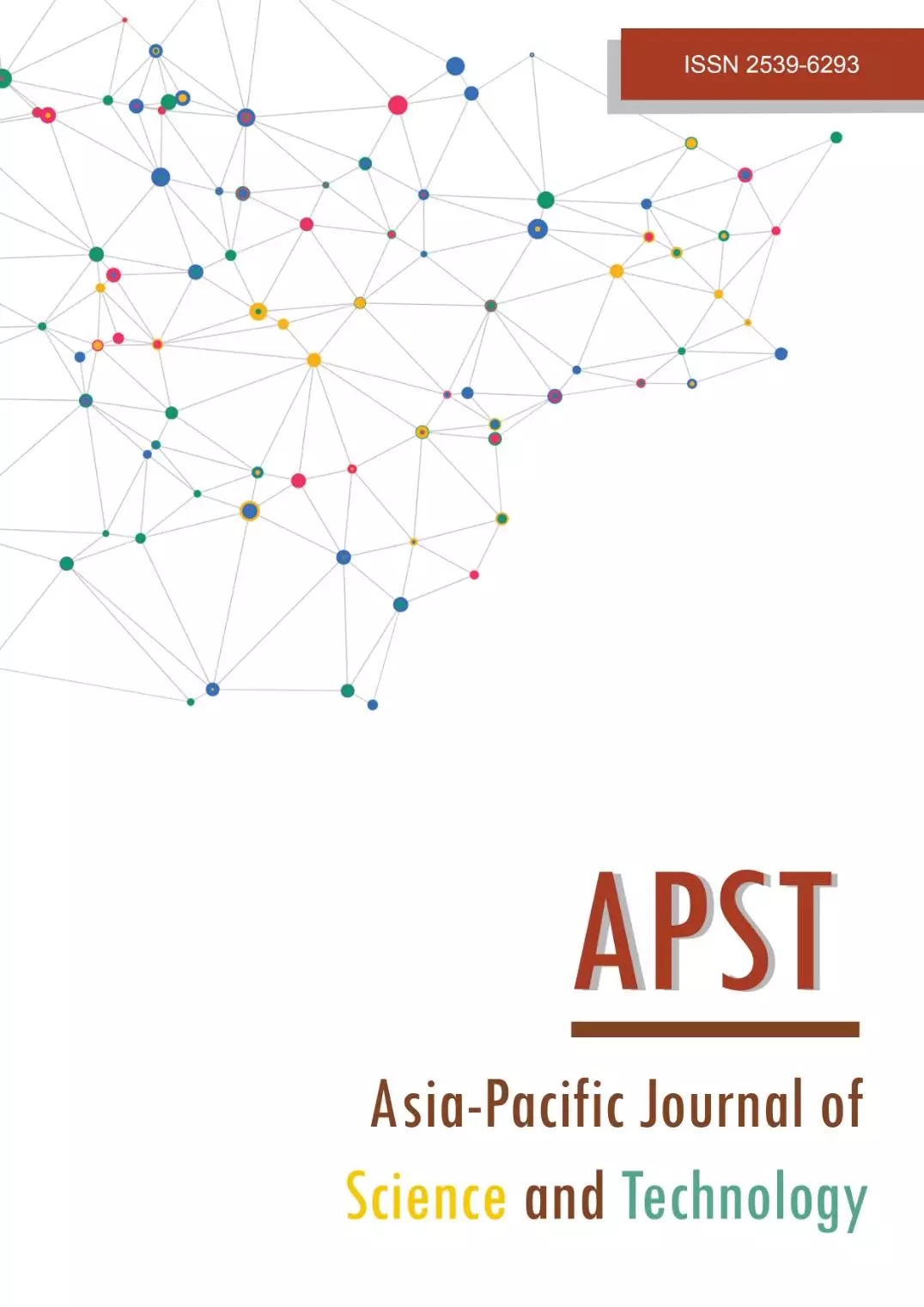Effect of extraction conditions on physical and antioxidant properties of Yanang (Tiliacora triandra) leaf extract
Main Article Content
Abstract
The purpose of this study was to investigate the effect of extraction conditions on the physical and antioxidant properties of Yanang (Tiliacora triandra) leaf extract. The studied extraction conditions were leaves to water ratio (1:6 and 1:9), blending speed (22,000 and 32,000 rpm), heating temperature (60, 70, and 80 °C), and heating time (1, 3, 6, 9, 12, and 15 min). The extracts were examined for physical (color and stability) and antioxidant total phenolic content (TPC), 2,2-diphyneyl-2-picryl-hydrazyl (DPPH) radical scavenging activity, and Xanthine oxidase inhibitory activity) properties. Delta E (∆E*) decreased with an increase in ratio but it increased with increase blending speed. Increases in ratio, blending speed, and time lowered the stability, however, the temperature did not affect the stability. The antioxidant properties improved when the ratio and blending speed increased. Higher temperature and longer time declined the antioxidant properties of the extract. Results showed that the extraction conditions much affected antioxidant activity than physical properties. The degradation of TPC followed the zero-order reaction (R2 0.676-0.938) while the degradations of DPPH radical scavenging (R2 0.738-0.969) and Xanthine oxidase inhibitory (XOI) activities (R2 0.790-0.986) followed the second-order reaction. The most suitable extraction condition was the extraction using a 1:9 ratio, 32,000 rpm, 60oC, and 1 min. This study proposed the Arrhenius equation of TPC, DPPH radical scavenging activity, and XOI activity with a correlation coefficient of 0.792, 0.938, and 0.735, respectively.
Article Details

This work is licensed under a Creative Commons Attribution-NonCommercial-NoDerivatives 4.0 International License.
References
Rattana S, Cushine B, Taepongsorat L, Phadungkit M. Chemical constituents and in vitro anticancer activity of Tiliacora triandra leaves. Pharmacogn J. 2016;8(1):1-3.
Singthong J, Ningsanond S, Cui SW. Extraction and physicochemical characterisation of polysaccharide gum from Yanang (Tiliacora triandra) leaves. Food Chem. 2009;114(4):1301-1307.
Rattana S, Padungkit M, Cushnie B. Phytochemical screening, flavonoid content, and antioxidant activity of Tiliacora triandra leaf extracts. In: Cushnie B, editor. The 2nd Annual International Conference of Northeast Pharmacy Research; 2010 Feb 13-14; Maha Sarakham, Thailand. Maha Sarakham: Mahasarakham University; 2010. p. 60-63.
Sireeratawong S, Lertprasertsuke N, Srisawat U, Thuppia A, Ngamjariyawat A, Suwanlikhid N, et al. Acute and subchronic toxicity study of the water extract from Tiliacora triandra (Colebr.) Diels in rat. Songklanakarin J Sci Technol. 2008;30(5):611-619.
Singthong J, Oonsivilai R, Oonmetta-aree J, Ningsanond S. Bioactive compounds and encapsulation of Yanang (Tiliacora triandra) leaves. Afr J Complement Altern Med. 2014;11(3):76-84.
Sriket P. Chemical components and antioxidant activities of Thai local vegetables. KM ITL Sci Technol J. 2014;14(1):18-24.
Azmi SMN, Jamal P, Amid A. Xanthine oxidase inhibitory activity from potential Malaysian medicinal plant as remedies for gout. Int Food Res J. 2012;19(1):159-165.
Umamaheswari M, Kumar AK, Somasundaram A, Sivashanmugam T, Subhadradevi V, Ravi TK. Xanthine oxidase inhibitory activity of some Indian medicinal plants. J Ethnopharmacol. 2007;109(3):547-551.
Rabeler F, Feyissa AH. Kinetic modeling of texture and color changes during thermal treatment of chicken breast meat. Food Bioproc Tech. 2018;11:1495-1504.
Ibarz A, Pagán J, Garza S. Kinetic models for colour changes in pear puree during heating at relatively high temperatures. J Food Eng. 1999;39(4):415-422.
Barreiro JA, Milano M, Sandoval AJ. Kinetics of colour change of double concentrated tomato paste during thermal treatment. J Food Eng. 1997;33(3-4):359-371.
Liu S, Sun C, Xue Y, Gao Y. Impact of pH, freeze-thaw and thermal sterilization on physicochemical stability of walnut beverage emulsion. Food Chem. 2016;196:475-485.
Tian J, Chen J, Lv F, Chen S, Chen J, Liu D, et al. Domestic cooking methods affect the phytochemical composition and antioxidant activity of purple-fleshed potatoes. Food Chem. 2016;197(Pt B):1264-1270.
Turturică M, Stănciuc N, Bahrim G, Râpeanu G. Effect of thermal treatment on phenolic compounds from plum (prunus domestica) extracts -a kinetic study. J Food Eng. 2016;171:200-207.
Fazaeli M, Hojjatpanah G, Djomeh EZ. Effects of heating method and conditions on the evaporation rate and quality attributes of black mulberry (Morus nigra) juice concentrate. J Food Sci Technol. 2013;50: (1):35-43.
Granato D, Masson ML, Ribeiro JCB. Sensory acceptability and physical stability evaluation of a prebiotic soy-based dessert developed with passion fruit juice. Food Sci Technol (Campinas). 2012; 32(1):119-126.
Ancos DB, Sgroppo S, Plaza L, Cano MP. Possible nutritional and health-related value promotion in orange juice preserved by high-pressure treatment. J Sci Food Agric. 2002;82(8):790-796.
Boonsong P, Laohakunjit N, Kerdchoechuen O. Identification of polyphenolic compounds and colorants from Tiliacora triandra (Diels) leaves. Agri Sci J. 2009;40(Suppl 3):13-16.
Kalt W. Effects of production and processing factors on major fruit and vegetable antioxidants. J Food Sci. 2005;70(1):R11-R19.
Phomkaivon N, Areekul V. Screening for antioxidant activity in selected Thai wild plants. As J Food Ag-Ind. 2009;2(04):433-440.
Taejarernwiriyakul O, Buasai M, Rattanatranurak I, Sriyod P, Chanluang S. Xanthine oxidase inhibitory activity of medicinal plants. Thai Pharm Health Sci J. 2011;6(1):1-6.
Owen PL, Johns T. Xanthine oxidase inhibitory activity of northern North American plants remedies used for gout. J Ethnopharmacol. 1999;64(2):149-160.
Ramallo IA, Zacchino SA, Furlan RLE. A rapid TLC autographic method for the detection of xanthine oxidase inhibitors and superoxide scavengers. Phytochem Anal. 2006;17(1):15-19.
Valentão P, Fernandes E, Carvalho F, Andrade PB, Seabra RM, Bastos ML. Antioxidant activity of Centaurium erythraea infusion evidenced by its superoxide radical scavenging and xanthine oxidase inhibitory activity. J Agri Food Chem. 2001;49(7):3476-3479.
Jiwajinda S, Santisopasri V, Murakami A, Kim OK, Kim HW, Ohigashi H. Suppressive effects of edible Thai plants on superoxide and nitric oxide generation. Asian Pac J Cancer Prev. 2002;3(3):215-223.


